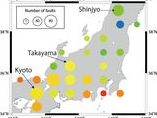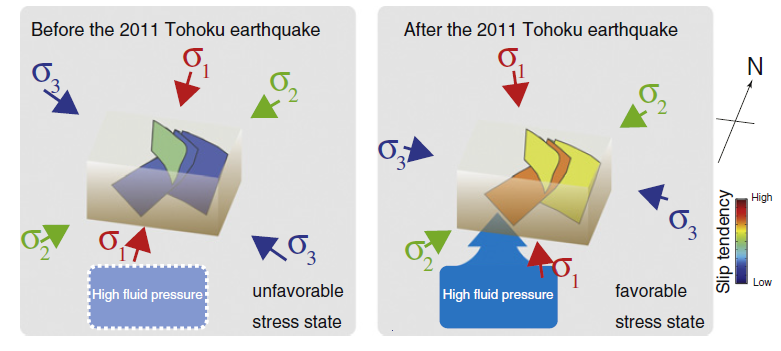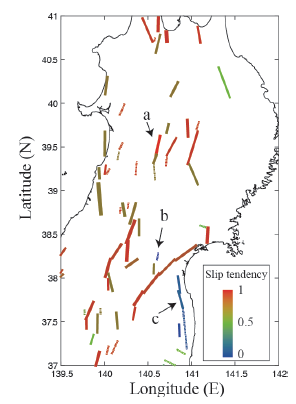We study the dynamics (geomechanics) of the Earth, especially the movement of faults. This research addresses how earthquakes occur and how we can assess them. To find faults that are prone to earthquakes, we calculate slip tendencies based on the relationship between the force field acting on the crust (stress field) and the orientation of the fault. Using this method, we can numerically indicate how likely a fault is to slip, enabling us to assess earthquakes more accurately. Through these studies, we aim to make significant contributions to the assessment and understanding of earthquakes.
Differences in mechanical conditions between active and inactive faults
|
We investigated the susceptibility of faults to activity from the Tohoku to Kinki regions by calculating slip tendencies based on the relationship between the force field (stress field) acting on the crust and the orientation of the fault.
Active faults in any of the regions from the Tohoku to Kinki regions also have high slip tendencies, suggesting that active faults in these regions reflect stresses in the Earth's crust.
On the other hand, for faults that are not considered active faults (geological faults), we found that there are several geological faults with low slip tendency in the Tohoku region, but high slip tendency in the Kinki region.
These geological faults with high tendency to slip may become active in the future on a long geologic time scale. This finding may be useful for hazard assessment. See: Miyakawa and Otsubo (2017) |

|
Mechanism of the 2011 earthquake in Hamadori, Fukushima Prefecture
|
The April 11, 2011 earthquake in Hamadori, Fukushima Prefecture (Mw 6.6) was a large inland earthquake that occurred shortly after the 2011 off the Pacific Coast of Tohoku Earthquake.
We investigated the mechanism of this earthquake by calculating the slip tendency based on the relationship between the force field (stress field) acting on the crust in this region and the orientation of the fault that caused the 2011 earthquake in Hamadori, Fukushima Prefecture.
The analysis revealed that this earthquake was related to water pressure deep underground, providing a clue to understanding the mechanism of earthquakes. See: Miyakawa and Otsubo (2015) |

|
Use of slip tendency to assess fault activity
|
In the past, investigations of active faults that cause earthquakes have been based on when the fault was active in the past (i.e., when it caused the earthquake), and the possibility that the fault will be active in the future in a similar manner.
On the other hand, it is not always possible to know when a fault was active.
Therefore, we studied the use of fault activity assessment using slip tendency as a method to find faults that are prone to earthquakes.
This method provides a numerical value of the likelihood of a fault slip and can be used to estimate future earthquakes. See: Miyakawa and Otsubo (2015) |

|
